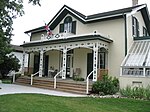Steve Brown Sports Complex
Athletics (track and field) venues in OntarioIndoor arenas in OntarioMulti-purpose stadiums in CanadaSoccer venues in Ontario

Steve Brown Sports Complex is a multi-purpose outdoor sports facility in Brantford, Ontario and located at Lions Park on 20 Edge Street. Built original in 1972 as Lions Park arena, which included a banquet hall for community purposes. Later expanded to include a track field with several baseball and soccer fields with a seating capacity of 2000. In 2002, the exterior part of the facility was renamed in honor of community leader and organizer Steve Brown. In 2010, the facility was upgraded in order to serve as the home venue to the Canadian Soccer League's newest franchise the Brantford Galaxy.
Excerpt from the Wikipedia article Steve Brown Sports Complex (License: CC BY-SA 3.0, Authors, Images).Steve Brown Sports Complex
Edge Street, Brantford
Geographical coordinates (GPS) Address Nearby Places Show on map
Geographical coordinates (GPS)
| Latitude | Longitude |
|---|---|
| N 43.121583333333 ° | E -80.270194444444 ° |
Address
Edge Street
N3T 1R6 Brantford
Ontario, Canada
Open on Google Maps










